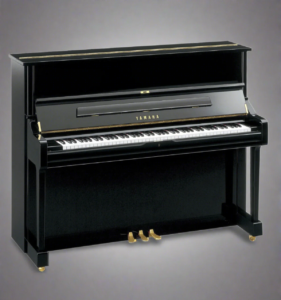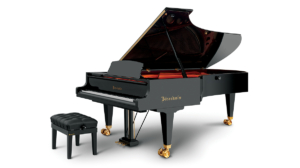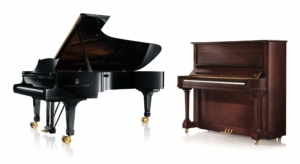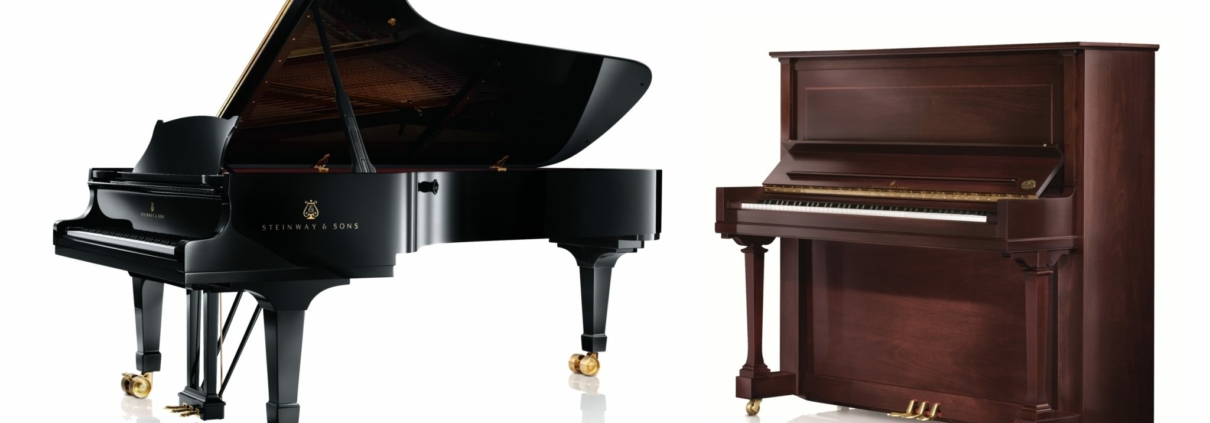Grand Piano vs Upright Piano – Which Choices Are Suitable For You?
Grand piano vs upright pianos are the two primary types of pianos that have been extensively popular up to this point. There are fundamental variations in every line’s size, look, and methods of operation. Let’s figure out the factors to take into account while selecting your suitable pianos!
Reading More:
- Keyboard Piano Keys Layout
- Top 4 Piano App for Free
- How to tune the piano?
- Controlling Humidity for Pianos
- How to Maintain a Grand Piano
Which Features Are Different From Grand Piano vs Upright Piano?
What is an Upright Piano?
Vertical piano is another name for upright piano. It is modeled by the outside geometry of a piano line that is also a vertical rectangular box. It has a young, tidy, and uncomplicated style. Furthermore, the result is just as opulent.

Upright Piano
Nowadays, a lot of tea shops, hotels, bars, schools, and homes prefer upright pianos. This makes the product well-liked by a large number of Vietnamese consumers.
What is a Grand Piano?
In the high-end musical instrument market, grand pianos are also referred to as pianos or three-legged pianos. As their name implies, these are huge instruments. It is frequently used as décor in opulent restaurants and homes or in professional performances.

Grand Piano
Therefore, even in the mid-range client category, it is very difficult to imagine what a grand piano is. Due to their familiarity, they presume that the piano is an upright piano.
To put it another way, upright pianos are targeted towards mid-range buyers, whereas grand pianos are at the upper end of the market. Regarding robustness, caliber, and auditory elements, every kind possesses unique benefits.
Basic Difference Between Grand Piano vs Upright Piano
Here are some basic differences between upright grand piano vs upright piano:

Basic Difference Between Grand Piano vs Upright Piano
Operating mechanism
Grand piano strings run horizontally and parallel to the ground. Because of gravity, the hammer returns to its starting position quickly and precisely (the fastest key response speed is 14 times/second).
Since the upright piano has a vertical design, the strings and mechanism are likewise vertical. Relying on a complicated and advanced system using springs to draw the hammer back to the original position. It will therefore be more difficult to play songs that call for constant key bouncing (the trill technique) because the reaction will be slower than on a grand piano (the fastest key response speed is seven times/second). We think you start knowing the differences between grand piano vs regular piano.
Pedal
Pedal mechanism and functioning differ between Grand and Upright Pianos:
| Grand Piano | Upright Piano | |
| Left Pedal | Another name for a shifter is a “soft pedal” or “una corda pedal”. The entire keyboard will move to the right when this pedal is activated, which will help adjust the note’s pitch in addition to its volume. | Soft pedal: This pedal helps to lessen the force of the impact and the sound produced by shortening the distance between the hammer and the string. |
| Right Pedal | Sustain pedal: Also known as a “damper pedal” helps retain the resonance of the note even when you lift your hand from the keyboard. | Muffle pedal: Also referred to as a practice pedal, this pedal produces a softer sound and a heavier key by pressing on a tiny felt piece that is positioned between the string and the hammer. |
| Middle Pedal | The sostenuto pedal raises the hammer off the strings of any key that is being played before depressing it. This maintains the chosen notes’ ringing tone. | Sustain pedal: Also referred to as a “damper pedal,” it aids in keeping the note’s resonance after you take your hand off the keyboard. |
For use
Most users would be better off with upright pianos. They can be used by educators, musicians, and performers alike. This is especially a suggested option for people who wish to study the piano and have a strong passion for it.
Grand pianos are usually used for exhibition or performances in opulent settings. Grand pianos are not often used for instruction or learning.
Conclusion
Despite its disparate exteriors, every piano is an excellent musical instrument. You can select a style that complements your interior design while remaining assured that this will be a family instrument for many years to come.
Follow pianos in the parks to learn more about piano!




Leave a Reply
Want to join the discussion?Feel free to contribute!